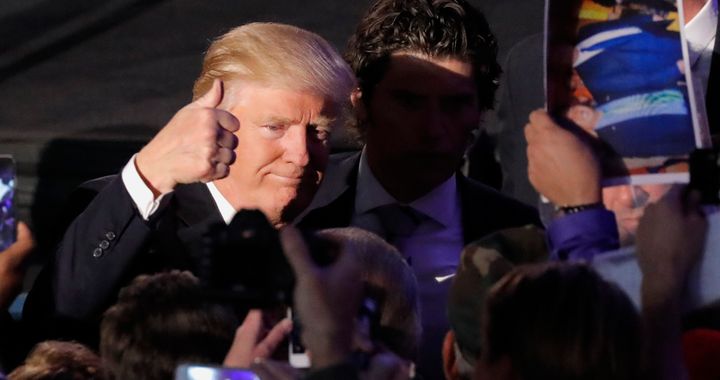
It’s exciting to see some pundits recognizing that Trump won partly because people thought he had big plans to rebuild the economy. And some are asking: is there any chance the Democrats can counter with their own big plans? But Trump’s “big” plans for the economy — on top of being really vague — are actually pretty small. Nevertheless, it’s true that they’re bigger than anything the Democrats have proposed for decades. A deeply ingrained taboo against government spending to rebuild the economy prevents Trump Republicans and even Bernie Democrats from thinking as big as our current troubles requires. It’s time to examine and get over this taboo.
Trump’s trillion for infrastructure is less than one third of what the American Society of Civil Engineers prescribe to reverse a half century of neglect. Trump is held back by the same taboo that made Hillary propose only $275 billion for infrastructure. It’s a taboo against letting the government organize sweeping economic activity that would benefit America. Even progressives let this taboo shrink down their political hopes and dreams. It’s why Bernie Sanders proposed only $1.6 trillion for infrastructure — four tenths of the full bill. And infrastructure repair is only one job of many that our country needs us to knock out. We need to jettison this taboo that prevents we, the people, from making big structural changes to our economy.
Trump’s trillion for infrastructure is interesting because it’s a sign that today even Republicans have come around to supporting big spending on non-military projects. What opened their minds? It’s the growing consensus that the government won’t be able to keep all of Wall Street’s financial bubbles inflating for much longer by merely keeping interest rates at zero and throwing more trillions at bankers. They are worried about the next recession and how, to paraphrase Larry Summers, all the old bubble-inflation tools are fully exhausted and haven’t had time to recharge since the “Great Recession” of 2008. Establishment figures like Larry Summers and our probable next Treasury Secretary Steve Mnuchin are looking to “fiscal policy” through infrastructure projects as the next policy lever to keep the bubbles blowing and the economy slowly growing.
But Americans want more than that. They want better jobs in every sector, and an economy that works for everyone. So why not go all the way? For infrastructure, that means spending the full $3.6 trillion the experts say is necessary. But we can’t stop there. And why would we? As a country, we’ve intentionally organized massive economic transformations before. Today, we don’t need mere growth in output — we need transformation from low wage to high wage jobs, from carbon to clean manufacturing and transportation, from a high-waste consumer economy to a zero-waste consumer economy and more. Today the world is full of countries where governments and their people intentionally modernized and transformed economies. Domestically, we have a recent example: the economic transformation before and during the second world war.
Around World War II, we committed nearly half of ourGDP in an effort that turned our economy into something that would have been totally unrecognizable to previous generations. There is a misconception that the urgency of war made it possible. But there was no urgency of war during the first several years of the transformation, except in President Roosevelt’s mind. Almost no one except him believed war was coming. FDR promised convincingly in his reelection campaign that he wouldn’t go to war under any circumstances. Congress dragged its feet and refused to pay for war preparations. Huge numbers of Americans supported Hitler and Mussolini, demonstrating their support in mass rallies and political organization.
Roosevelt’s accidental masterstroke was hiring Bill Knudsen, the CEO of General Motors, to lead the preparations, at the recommendation of the guy who did the job in World War I. Everyone around Knudsen told him he’d be crazy to take the job. But Knudsen, a shop-floor educated Danish immigrant, had the special motivation of six unreachable sisters back home in Nazi-occupied Denmark. FDR made Knudsen a four star general and gave him a military plane. Knudsen flew around the country quietly convincing machine tool companies and others at the top of supply chains to invest in additional capacity. As war became inevitable and Congress began approving expenditures, the foundation laid by Knudsen allowed manufacturers to quickly expand the production of everything from steel, guns, automobiles and airplanes to new high tech products like radios and radar and things no one had dreamed of before the war. Knudsen drove the effort to transform the economy without a single act of nationalization or coercion toward a company.
Americans made a great living from the WWII economy for decades. People lucky enough to work for the biggest firms and their key suppliers used the power of the strike to win middle-class incomes. Since North America was practically the only piece of the world industrial economy left standing after the war, employers had to negotiate with their workers. But over time, as U.S. corporations expanded production into low wage markets, workers lost their bargaining power. From 1977, the same year America began running trade deficits with the rest of the world, real wages began stagnating for the nation, and declining for most workers.
What allowed us to do that back then, and why can’t we do it now? The conventional answer is, again, the urgency of war. Only in war time would our country agree to go so deeply into debt to intentionally transform our economy. World War II put the fire under our collective feet that allowed us to take on a record debt of 120% of GDP. So goes the story. But today we’re already up to a public debt of 100% of GDP. What got us here? Not a world war, but just some banks that needed bailing out, some reckless tax cuts for the rich, and some regional wars we chose to fight because some geniuses in the Bush Administration thought it would be cool to build utopia in the Middle East. (On second, thought, I guess it’s a good thing that they didn’t try to rebuild America!)
What really allowed us to transform our economy around World War II was not urgency, but ideology. In 1943, Friedrich Hayek the grandfather of neoconservative economics, said the only reason economists and even business people had stopped saying, “we are all socialists now” was that it was obvious to everyone. Even people who believed they would lose out in a socialist future didn’t hope to prevent it, but just to delay in favor of their class or interest. Planned economies were growing so fast under diverse political systems from fascist dictatorships to liberal democracies that their superiority was understood by virtually everyone to be self evident.
But in America, our institutions of private property and rule of law were so strong that no one powerful ever thought seriously about nationalizing industries in the war transformation like they did in Britain, other European countries, and Japan. Of course, the Soviet Union was already a fully planned economy. Knudsen served as an organizer, not a dictator, making deals, extending credit, and pulling together partnerships. He did have a grand plan, but he had to provide incentives, or promises of future incentives, to get manufacturers on board. The minutiae of the plan would be worked out between companies using market mechanisms, not a game of telephone between potentially out-of-touch planners.
Though it contradicted what most people believed at the time, the limitations of democracy, free enterprise and private property actually made the United States the most adept at transforming its economy through central planning.
So why can’t we do it again? We’re already willing to take the supposed financial risks of going deeply into debt merely to avoid falling asset prices. And Americans probably feel a lot more public and private urgency around our economic woes and about climate change than our great grandparents did for the rise of Hitler by the time Knudsen was already well into his transformation project.
We are ready! All we need is political leadership — the kind offered by Roosevelt when he hired Knudsen. It’s true that Roosevelt believed that America was going to have to enter the European war eventually. So he did feel that urgency. But WE all feel the urgency of declining incomes and rising oceans right now. That’s why it’s time, and why it’s reasonable today, for us to start thinking like Bill Knudsen again, and start making big plans for the transformation of our economy.
Zack Exley is a volunteer with Brand New Congress, a campaign to recruit 400+ candidates to run for Congress behind a plan to rebuild the economy. Please check it out at BrandNewCongress.org
